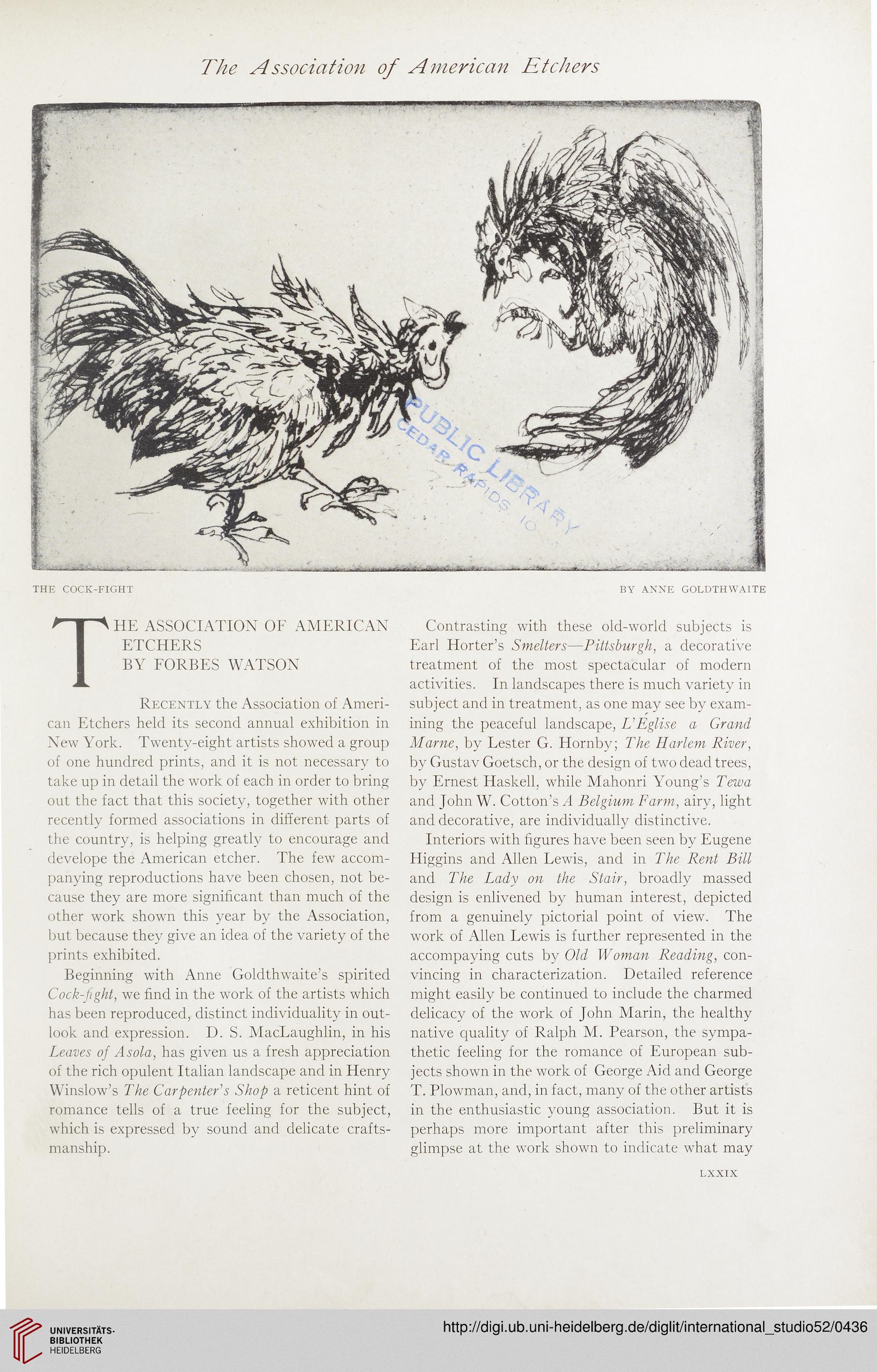The Association of American Etchers
THE COCK-FIGHT
BY ANNE GOLDTHWAITE
The association of American
ETCHERS
BY FORBES WATSON
Recently the Association of Ameri-
can Etchers held its second annual exhibition in
New York. Twenty-eight artists showed a group
of one hundred prints, and it is not necessary to
take up in detail the work of each in order to bring
out the fact that this society, together with other
recently formed associations in different parts of
the country, is helping greatly to encourage and
develope the American etcher. The few accom-
panying reproductions have been chosen, not be-
cause they are more significant than much of the
other work shown this year by the Association,
but because they give an idea of the variety of the
prints exhibited.
Beginning with Anne Goldthwaite’s spirited
Cock-fight, we find in the work of the artists which
has been reproduced, distinct individuality in out-
look and expression. D. S. MacLaughlin, in his
Leaves of A sola, has given us a fresh appreciation
of the rich opulent Italian landscape and in Henry
Winslow’s The Carpenter’s Shop a reticent hint of
romance tells of a true feeling for the subject,
which is expressed by sound and delicate crafts-
manship.
Contrasting with these old-world subjects is
Earl Horter’s Smelters—Pittsburgh, a decorative
treatment of the most spectacular of modern
activities. In landscapes there is much variety in
subject and in treatment, as one may see by exam-
ining the peaceful landscape, L’Eglise a Grand
Marne, by Lester G. Hornby; The Idarlem River,
by Gustav Goetsch, or the design of two dead trees,
by Ernest Haskell, while Mahonri Young’s Tewa
and John W. Cotton’s A Belgium Farm, airy, light
and decorative, are individually distinctive.
Interiors with figures have been seen by Eugene
Higgins and Allen Lewis, and in The Rent Bill
and The Lady on the Stair, broadly massed
design is enlivened by human interest, depicted
from a genuinely pictorial point of view. The
work of Allen Lewis is further represented in the
accompaying cuts by Old Woman Reading, con-
vincing in characterization. Detailed reference
might easily be continued to include the charmed
delicacy of the work of John Marin, the healthy
native quality of Ralph M. Pearson, the sympa-
thetic feeling for the romance of European sub-
jects shown in the work of George Aid and George
T. Plowman, and, in fact, many of the other artists
in the enthusiastic young association. But it is
perhaps more important after this preliminary
glimpse at the work shown to indicate what may
LXXIX
THE COCK-FIGHT
BY ANNE GOLDTHWAITE
The association of American
ETCHERS
BY FORBES WATSON
Recently the Association of Ameri-
can Etchers held its second annual exhibition in
New York. Twenty-eight artists showed a group
of one hundred prints, and it is not necessary to
take up in detail the work of each in order to bring
out the fact that this society, together with other
recently formed associations in different parts of
the country, is helping greatly to encourage and
develope the American etcher. The few accom-
panying reproductions have been chosen, not be-
cause they are more significant than much of the
other work shown this year by the Association,
but because they give an idea of the variety of the
prints exhibited.
Beginning with Anne Goldthwaite’s spirited
Cock-fight, we find in the work of the artists which
has been reproduced, distinct individuality in out-
look and expression. D. S. MacLaughlin, in his
Leaves of A sola, has given us a fresh appreciation
of the rich opulent Italian landscape and in Henry
Winslow’s The Carpenter’s Shop a reticent hint of
romance tells of a true feeling for the subject,
which is expressed by sound and delicate crafts-
manship.
Contrasting with these old-world subjects is
Earl Horter’s Smelters—Pittsburgh, a decorative
treatment of the most spectacular of modern
activities. In landscapes there is much variety in
subject and in treatment, as one may see by exam-
ining the peaceful landscape, L’Eglise a Grand
Marne, by Lester G. Hornby; The Idarlem River,
by Gustav Goetsch, or the design of two dead trees,
by Ernest Haskell, while Mahonri Young’s Tewa
and John W. Cotton’s A Belgium Farm, airy, light
and decorative, are individually distinctive.
Interiors with figures have been seen by Eugene
Higgins and Allen Lewis, and in The Rent Bill
and The Lady on the Stair, broadly massed
design is enlivened by human interest, depicted
from a genuinely pictorial point of view. The
work of Allen Lewis is further represented in the
accompaying cuts by Old Woman Reading, con-
vincing in characterization. Detailed reference
might easily be continued to include the charmed
delicacy of the work of John Marin, the healthy
native quality of Ralph M. Pearson, the sympa-
thetic feeling for the romance of European sub-
jects shown in the work of George Aid and George
T. Plowman, and, in fact, many of the other artists
in the enthusiastic young association. But it is
perhaps more important after this preliminary
glimpse at the work shown to indicate what may
LXXIX




